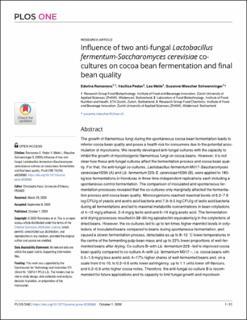Bitte benutzen Sie diese Kennung, um auf die Ressource zu verweisen:
https://doi.org/10.21256/zhaw-21140| Publikationstyp: | Beitrag in wissenschaftlicher Zeitschrift |
| Art der Begutachtung: | Peer review (Publikation) |
| Titel: | Influence of two anti-fungal Lactobacillus fermentum-Saccharomyces cerevisiae co-cultures on cocoa bean fermentation and final bean quality |
| Autor/-in: | Romanens, Edwina Pedan, Vasilisa Meile, Leo Miescher Schwenninger, Susanne |
| et. al: | No |
| DOI: | 10.1371/journal.pone.0239365 10.21256/zhaw-21140 |
| Erschienen in: | PLOS ONE |
| Band(Heft): | 15 |
| Heft: | 10 |
| Seite(n): | e0239365 |
| Erscheinungsdatum: | 1-Okt-2020 |
| Verlag / Hrsg. Institution: | Public Library of Science |
| ISSN: | 1932-6203 |
| Sprache: | Englisch |
| Fachgebiet (DDC): | 664: Lebensmitteltechnologie |
| Zusammenfassung: | The growth of filamentous fungi during the spontaneous cocoa bean fermentation leads to inferior cocoa bean quality and poses a health risk for consumers due to the potential accumulation of mycotoxins. We recently developed anti-fungal cultures with the capacity to inhibit the growth of mycotoxigenic filamentous fungi on cocoa beans. However, it is not clear how these anti-fungal cultures affect the fermentation process and cocoa bean quality. For that, the anti-fungal co-cultures, Lactobacillus fermentum M017-Saccharomyces cerevisiae H290 (A) and Lb. fermentum 223-S. cerevisiae H290 (B), were applied to 180-kg box fermentations in Honduras in three time-independent replications each including a spontaneous control fermentation. The comparison of inoculated and spontaneous fermentation processes revealed that the co-cultures only arginally affected the fermentation process and cocoa bean quality. Microorganisms reached maximal levels of 6.2–7.6 log CFU/g of yeasts and acetic acid bacteria and 7.9–9.5 log CFU/g of lactic acid bacteria during all fermentations and led to maximal metabolite concentrations in bean cotyledons of 4–12 mg/g ethanol, 2–6 mg/g lactic acid and 6–14 mg/g acetic acid. The fermentation and drying processes resulted in 38–90 mg epicatechin equivalents/g in the cotyledons of dried beans. However, the co-cultures led to up to ten times higher mannitol levels in cotyledons of inoculated beans compared to beans during spontaneous fermentation, and caused a slower fermentation process, detectable as up to 8–12 ˚C lower temperatures in the centre of the fermenting pulp-bean mass and up to 22% lower proportions of well-fermented beans after drying. Co-culture B–with Lb. fermentum 223 –led to improved cocoa bean quality compared to co-culture A–with Lb. fermentum M017 –, i.e. cocoa beans with 0.5–1.9 mg/g less acetic acid, 4–17% higher shares of well-fermented beans and, on a scale from 0 to 10, to 0.2–0.6 units lower astringency, up to 1.1 units lower off-flavours, and 0.2–0.9 units higher cocoa notes. Therefore, the anti-fungal co-culture B is recommended for future applications and its capacity to limit fungal growth and mycotoxin production during industrial-scale cocoa bean fermentation hould be investigated in further studies. |
| URI: | https://digitalcollection.zhaw.ch/handle/11475/21140 |
| Volltext Version: | Publizierte Version |
| Lizenz (gemäss Verlagsvertrag): | CC BY 4.0: Namensnennung 4.0 International |
| Departement: | Life Sciences und Facility Management |
| Organisationseinheit: | Institut für Lebensmittel- und Getränkeinnovation (ILGI) |
| Publiziert im Rahmen des ZHAW-Projekts: | Entwicklung antifungaler Schutzkulturen für die Kakaobohnenfermentation |
| Enthalten in den Sammlungen: | Publikationen Life Sciences und Facility Management |
Dateien zu dieser Ressource:
| Datei | Beschreibung | Größe | Format | |
|---|---|---|---|---|
| 2020_Romanens_etal_Influence-of-two-anti-fungal-Lactobacillus_PLOS-ONE.pdf | 2.13 MB | Adobe PDF |  Öffnen/Anzeigen |
Zur Langanzeige
Romanens, E., Pedan, V., Meile, L., & Miescher Schwenninger, S. (2020). Influence of two anti-fungal Lactobacillus fermentum-Saccharomyces cerevisiae co-cultures on cocoa bean fermentation and final bean quality. Plos One, 15(10), e0239365. https://doi.org/10.1371/journal.pone.0239365
Romanens, E. et al. (2020) ‘Influence of two anti-fungal Lactobacillus fermentum-Saccharomyces cerevisiae co-cultures on cocoa bean fermentation and final bean quality’, PLOS ONE, 15(10), p. e0239365. Available at: https://doi.org/10.1371/journal.pone.0239365.
E. Romanens, V. Pedan, L. Meile, and S. Miescher Schwenninger, “Influence of two anti-fungal Lactobacillus fermentum-Saccharomyces cerevisiae co-cultures on cocoa bean fermentation and final bean quality,” PLOS ONE, vol. 15, no. 10, p. e0239365, Oct. 2020, doi: 10.1371/journal.pone.0239365.
ROMANENS, Edwina, Vasilisa PEDAN, Leo MEILE und Susanne MIESCHER SCHWENNINGER, 2020. Influence of two anti-fungal Lactobacillus fermentum-Saccharomyces cerevisiae co-cultures on cocoa bean fermentation and final bean quality. PLOS ONE. 1 Oktober 2020. Bd. 15, Nr. 10, S. e0239365. DOI 10.1371/journal.pone.0239365
Romanens, Edwina, Vasilisa Pedan, Leo Meile, and Susanne Miescher Schwenninger. 2020. “Influence of Two Anti-Fungal Lactobacillus Fermentum-Saccharomyces Cerevisiae Co-Cultures on Cocoa Bean Fermentation and Final Bean Quality.” Plos One 15 (10): e0239365. https://doi.org/10.1371/journal.pone.0239365.
Romanens, Edwina, et al. “Influence of Two Anti-Fungal Lactobacillus Fermentum-Saccharomyces Cerevisiae Co-Cultures on Cocoa Bean Fermentation and Final Bean Quality.” Plos One, vol. 15, no. 10, Oct. 2020, p. e0239365, https://doi.org/10.1371/journal.pone.0239365.
Alle Ressourcen in diesem Repository sind urheberrechtlich geschützt, soweit nicht anderweitig angezeigt.